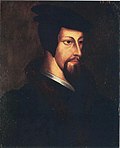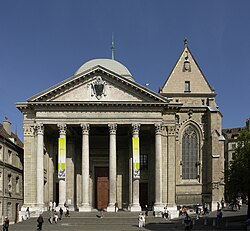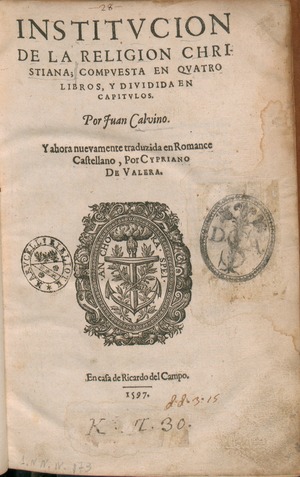John Calvin
Jean Cauvin, or Jean Calvin (English: John Calvin, July 10, 1509 – May 27, 1564), was a French Protestant theologian during the Protestant Reformation who was a central developer of the system of Christian theology that is called Calvinism or Reformed theology. In Geneva, he rejected papal authority and established a new scheme of civic and ecclesiastical governance. He is famous for his teachings and writings and infamous for his role in the execution of Michael Servetus.
John Calvin | |
|---|---|
 Engraving from the original oil painting in the University Library of Geneva | |
| Born | July 10, 1509 |
| Died | May 27, 1564 (aged 54) |
| Occupation | Pastor and theologian |
| Spouse(s) | Idelette de Bure |
| Parent(s) | Gérard Cauvin and Jeanne Lefranc |
Early life
Calvin was born with the name Jean Chauvin (or Cauvin, Latin: Calvinus) in Noyon, Picardy (now Oise department), France, to Gérard Cauvin and Jeanne Lefranc. In 1523, Calvin's father, a lawyer, sent his 14-year-old son to the University of Paris to study thehumanities and law. By 1532, he had attained a Doctor of Law degree at Orléans.
In 1536, he settled in Geneva, Switzerland. After being expelled from the city, he served as a pastor in Strasbourg from 1538 to 1541, when he returned to Geneva, where he lived until his death.
Thought
Calvin trained to be a lawyer. He studied with some of the best teachers of the Renaissance in France. Some of the training used newer humanistic methods of trying to understand to deal with a text directly. His training was important for Calvin. When he started to believe in Evangelicalism, he used those methods with the Bible, which he used form his thoughts. He taught and preached what he believed that the Bible taught.
Reformers such as Jan Hus and Martin Luther are seen as original thinkers who started a movement. Calvin was a great logician.and organised a movement but did not start as much doctrine. He knew very well the writings of the early Church Fathers and the great medieval scholastics. Earlier Reformers also influenced Calvin, who did not disagree with all medieval scholastics but used them and adapted their thoughts according to his understanding of the Bible.
Calvin is often associated with the doctrines of predestination and election. He had similar ideas to those of other magisterial Reformers about them.
Last years (1555–1564)

Calvin's power was very great in his last years. He was known all around the world as a reformer who was different from Luther.[1] Mainly, Luther and Calvin respected each other. However, Luther and a Zürich reformer, Huldrych Zwingli, thought differently about the Eucharist. Calvin's thoughts about it made Luther believe that Calvin agreed with Zwingli. However, Calvin was sad that the reformers were not all together. He tried to join them together by signing the Consensus Tigurinus, an agreement between the Zürich and the Geneva churches.
Calvin's greatest help to the English-speaking people was by giving protection to Marian exiles in Geneva starting in 1555. With the city's protection, they could make their own reformed church under John Knox and William Whittingham. They later carried many of Calvin's ideas back to England and Scotland.[2] However, Calvin was most interested in trying to change his homeland, France. He helped the building of churches by giving out literature and offering ministers. Between 1555 and 1562, over 100 ministers were sent to France.

In Geneva, Calvin mainly wanted to make a collège, a school for children. A site was chosen on March 25, 1558. The school was opened on June 5, 1559. It was divided into two parts. One part was a grammar school, which was called the collège or schola privata. The other part was an advanced school, the académie or schola publica. In five years, there were 1,200 students in the grammar school and 300 in the advanced school. The collège later became the Collège Calvin, one of the college preparatory schools of Geneva. The académie became the University of Geneva.[3][4]
In autumn 1558, Calvin became ill with a fever. He was afraid that he would die before he could finish the last revision of his Institutes of the Christian Religion, which made him force himself to work. The last edition became much longer and so Calvin called it a new work. The second-last edition had 21 chapters, but the last edition had 80 since he put more detail in the material that was already there though he did not really add more subjects.[5]
He became better, but he soon strained his voice while he was preaching, which made him cough violently. He had burst a blood vessel in his lungs. His health became much worse afterward. He preached his last sermon in St. Pierre Cathedral on February 6, 1564. On April 25, he made his will in which he left a little money to his family and to the collège. A few days later, the ministers of the church came to visit him. He died on May 27 of septicaemia.[6] The farewell is recorded in Discours d'adieu aux ministres.
The next day, he was buried in an unmarked grave in the Cimetière de Plainpalais.[7] The exact spot of the grave is unknown. However, a stone was added in the 19th century to mark a grave that has traditionally been thought to be Calvin's.[8]
John Calvin Media
William Farel was the reformer who persuaded Calvin to stay in Geneva. 16th-century painting. In the Bibliothèque Publique et Universitaire, Geneva.
Reading from the first chapter of Institutes of the Christian Religion in the original Latin, with English subtitles
Idelette and Calvin had no children survive infancy.
Michael Servetus exchanged many letters with Calvin until he was denounced by Calvin and executed.
Bibliography
General collections
- Works by John Calvin at Project Gutenberg
- Writings of Calvin at the Christian Classics Ethereal Library (CCEL)
Theological works
- Institutes of the Christian Religion at CCEL
- Psychopannychia
- Jean Calvin, Théodore de Bèze, [1]
Commentaries
- Calvin's Commentaries on the Bible at CCEL
- Commentaries on the Catholic Epistles, (with Calvin's dedication to Edward VI), tr. by John Owens, Edingurgh, The Calvin Translation Society, 1855.
Letters
- Jules Bonnet, Letters of John Calvin, Carlisle, Penn: Banner of Truth Trust 1980. ISBN 0-85151-323-9
Secondary sources
- Bernard Cottret, Calvin, a Biography, Grand Rapids, Michigan, Eerdmans, 2001. ISBN 0-567-08757-3
- Roland Bainton (1974). Women of the Reformation in England and France. Boston, MA: Beacon Press. ISBN 0-8070-5649-9.
- John Farrell, "The Terrors of Reform," chapter five of Paranoia and Modernity: Cervantes to Rousseau. Cornell University Press, 2006.
- John Foxe. An Account of the Life of John Calvin
References
- ↑ Cottret 2000, p. 235
- ↑ Parker 2006, pp. 170–172
- ↑ University of Geneva
- ↑ Olsen 2004, pp. 158–159; Ganoczy 2004, pp. 19–20; Cottret 2000, pp. 256–259; Parker 2006, pp. 157–160
- ↑ Parker 2006, pp. 161–164
- ↑ George, Timothy (January 1, 1990). John Calvin and the Church: A Prism of Reform. Westminster John Knox Press. p. 66. ISBN 978-0-664-25093-5.
- ↑ McGrath 1990, pp. 195–196; Cottret 2000, pp. 259–262; Parker 2006, pp. 185–191
- ↑ Rossel, Patrice (1994), Une visite du cimetière de Plainpalais, Les Iles futures; Palfi, Véronique (2003), Le Cimetière des Rois, De l'hôpital des pestiférés au cimetière de Plainpalais, Cinq siècle d'histoire, étude historique pour la Conservation architecturale de la Ville de Genève






